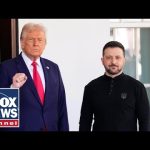The recent meeting between President Trump and Russian President Vladimir Putin was a spectacle that left many wondering about the true state of affairs between the two leaders. While the president smirked and engaged with Putin, overhead, the powerful B-2 bomber and F-35 fighter jets executed a flyover that echoed strength and military competence. This aerial display was reminiscent of the decisive actions taken by President Trump in the past, particularly when he ordered strikes on Iranian nuclear facilities. It conveyed a clear message that America stands ready to defend its interests, and that is something Putin cannot ignore.
During their conversation, President Trump emphasized that there was “no deal yet” on the table. His assertive stance suggested he wouldn’t settle for anything less than a fair agreement, which is reassuring given the perennial threat that Putin poses. While Putin tried to paint a rosy picture of their relationship, the reality is that no commitments were made, and the thoughtful negotiations surrounding Ukraine and NATO allies were prioritized. This strategic approach signaled a commitment to engaging with European leaders before making decisions that impact them directly—a refreshing change in dealing with a leader who often acts unilaterally.
As the conversation unfolded, it became clear that the core issues facing both leaders revolve around territory and security. Putin’s imperialistic designs on Ukraine and other neighboring countries raise a big question: Can he adhere to any agreement? History suggests otherwise. His insistence on expanding Russian influence—particularly in the Baltic States and even Finland—leaves little room for trust. He has not shied away from his ambitions, and as experts noted, his military maneuvers and territorial claims indicate that the threat remains real and persistent.
What adds a troubling layer to Putin’s ambitions is his ongoing campaign to take over and “re-educate” Ukrainian children. This alarming tactic underscores the inhumanity of his regime and highlights how critical it is for the international community to stand firm against his aggressive behavior. It’s clear that discussions alone won’t halt Putin’s dark designs. He needs to feel the weight of consequences, and only time will tell how the current administration plans to address this pressing issue.
Moreover, the broader stakes extend far beyond Ukraine. Putin’s military exercises with China in the Arctic demonstrate he views the United States as a formidable opponent, as both nations vie for influence on the world stage. The increasing collaboration between Russia and China is a cause for concern, particularly as these powers threaten American interests. Despite their attempts to portray a friendly relationship, Putin’s actions largely tell a different story.
In conclusion, while the recent meeting between President Trump and Putin made for gripping television, the underlying tensions were unmistakable. The fight for territory, security, and influence continues, and trust remains as elusive as ever. As President Trump navigates this complex landscape, the hope is that he will draw upon both strength and wisdom to meet the challenges posed by an assertive Russia. With careful diplomacy and a strong military presence, the administration can craft a strategy that protects America’s interests both at home and abroad.




